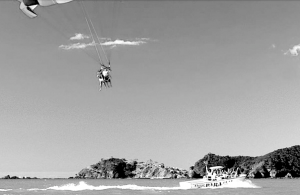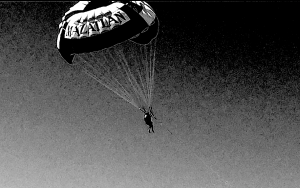My First and Last Resort (Mazatlán) - Part III
Another thing I enjoyed was sketching the two islands directly in front of our balcony. I did one sketch of Deer Island (above). In another drawing, in which I tried to capture the midday sun blazing on the water between Deer Island and Stone Island, I sketched in a couple of parasailors (below).
Looking over my shoulder while I sketched, Annette told me she gone parasailing once herself, and her now-twenty-three-year-old son had done it often, his first time as a ten-year old sitting on the lap of Raoul, the handsome parasailing vendor who was still working the beach the year I came there.
The parasailor is strapped into the parasail on a little deck out in the water, the boat pulls away towing the parasail behind, the wind lifts the parasailor up up up as the boat makes a circle. For ten minutes, the parasailor gets to enjoy a a view of the beach for miles, the sea, the islands, the marina, and the mountains, while hovering up there blissfully above it all.
Sometimes they might get another type of view. In Annette’s bathroom the coating on the window is reversed. One day a man waved at her in the shower as he sailed by. She told me she wasn’t upset, but she started hanging a towel over that window.
When the parasailor’s time is up, the pilot aligns the boat near the shore. Raoul unfurls a big yellow flag. and the parasailor is then supposed to pull a cord that opens a specially designed flap in the parasail. This results in the parasailor slowly drifting down to the beach−where two waiting men catch him from below and gently bring him to a soft landing on the sand.
Adios Mazatlán y Una Ultima Risa
During the pulmonia ride we took to the Mazatlán airport on the way home on Monday, I sat in the front seat next to a grandfatherly driver. While we were talking in Spanglish, he asked where I was going that day. I said, “Su casa.” He dryly replied, “Gracias,” with a twinkle in his eye, and then I realized I had said “his house” instead of “my house” and he was making a wry little joke on me. My last chuckle of many in Mazatlán.
The Perilous Side of Parasailing
By an odd coincidence, I learned quite a bit more about another side of parasailing in Mazatlán when I got back to work.
While I had been in Mexico, my company, Sun Microsystems, had laid off 4,000 people. It was expected, and I had been relieved that I was going to be away while the ax was being wielded. Two engineering managers that I’d worked with closely were replaced by another man I’d never met before, a man in his mid-thirties named Mark. Being thrust into the project late and having to catch up on the work of the two experienced managers who had been laid off, Mark had a lot of pressure riding on him.
When I returned a call from Mark the day I came back to work, I asked him how he was doing, and he said, “Ummmm.” I said reassuringly, “I know you’ll swim. You won’t sink.” And Mark replied, “But I know I’ll be swallowing a lot of seawater in the process.”
Then to explain where he had a vividly recalled experience of swallowing a lot of sea water, Mark launched into a story about what happened to him the day he went what he called “parasubmarining” in Mazatlán. I told him I just gotten back from there myself, and I was amused by the coincidence of him telling me about his adventure on the one day he’d visited there.
Mark was in his twenties when the cruise ship he was sailing on stopped at Mazatlán, and he said that the wildest party he ever attended in his life was at eleven o’clock in the morning at Senor Frog’s. After leaving Senor Frog’s late in the afternoon thoroughly inebriated, Mark decided to go parasailing.
He started from a little dock a ways out into the ocean. He had risen quite high into the air and was enjoying himself in a happy alcoholic haze−when the boat stalled. Mark and the parasail plummeted down into the water.
To understand what happened next, it would help if you can visualize the famous painting of Pieter Bruegel the Elder, “Landscape with the Fall of Icarus.” The painting shows people going about their daily business. A fisherman, a plowman, a shepherd, everyone in the picture is oblivious to Icarus’ fall. Icarus’ legs are protruding unnoticed from the sea as he falls head first into the water in the lower right of the canvas.
Like Icarus, Mark’s descent was unobserved, at least by the pilot of the boat. The pilot blithely assumed that the stall hadn’t lasted long enough for the parasail to drop, and he didn’t look back to check. He just started the boat up again and kept going. That’s when Mark began to swallow a lot of seawater.
The boat was pulling Mark one way and the parasail was full of water in the ocean behind him and pulling him the other way. I don’t know how he got out of it without being bifurcated, but I’m happy to know that he lived to tell the tale. Probably the boat’s pilot turned his back and finally figured out what was going on when he felt the unexpected drag of the water-filled parasail.
And that’s how I found out after I got back to work at Sun’s Network Storage Division in Newark, California that parasailing may not always be the lovely, idyllic, seemingly risk-free sport I had observed from the balcony in Mazatlán.






